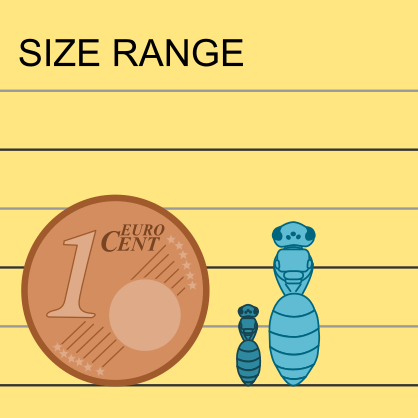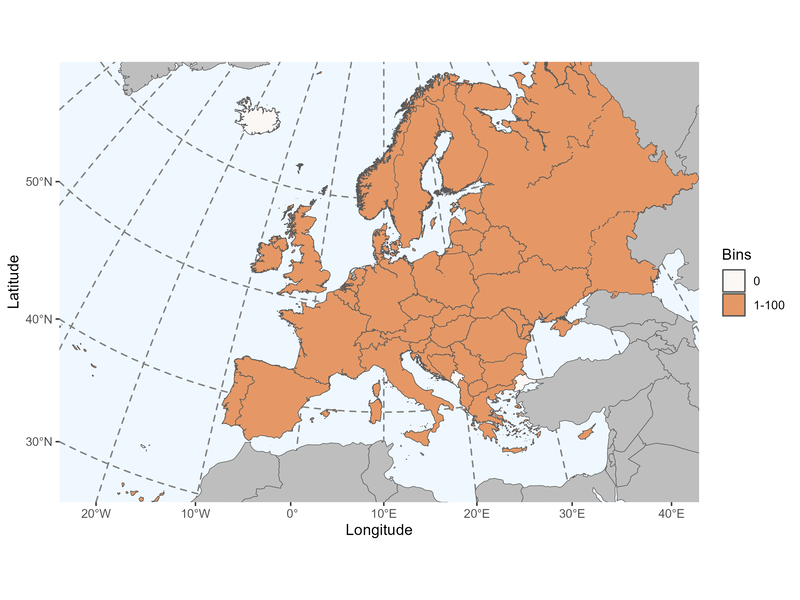Author: Latreille, 1802
|
Type species: Apis succincta Linnaeus, 1758, monobasic.
Synonyms: Evodia Panzer, 1806; Monia Westwood, 1875; Monidia Cockerell, 1905; Rhynchocolettes Moure, 1943. |
Clade: Anthophila
Family: Colletidae Subfamily: Colletinae Tribe: Colletini |
|
Distinctive traits
|
Pictures of distinctive traits.
(Sorry, there is no picture available at this time. If you have some and would like to become a contributor to IDmyBee, please contact us.) |
Morphologically close genera and how to distinguish them:
Halictus & Andrena have submarginal cells 2 smaller than 3, a tongue pointed and the second recurrent vein is arched or straight. T3 and T4 are the largest segments of the metasoma.
Apis females have a straight second recurrent vein, the marginal cell is banana-shaped, the eyes have hairs. Apis males have enlarged eyes meeting at the top of the head.
- Colletes - Halictus & Andrena
Halictus & Andrena have submarginal cells 2 smaller than 3, a tongue pointed and the second recurrent vein is arched or straight. T3 and T4 are the largest segments of the metasoma.
- Colletes - Apis
Apis females have a straight second recurrent vein, the marginal cell is banana-shaped, the eyes have hairs. Apis males have enlarged eyes meeting at the top of the head.
General comments on Colletes species identification
Colletes identification requires genitalia and seventh sternite exposed for the males. Punctation of propodeum and first tergites are important to identify the females.
Colletes identification requires genitalia and seventh sternite exposed for the males. Punctation of propodeum and first tergites are important to identify the females.
Sorry, but the species identification tool is not yet available for Colletes.
Please check the reference(s) at the bottom of the page for traditional keys.
Please check the reference(s) at the bottom of the page for traditional keys.
|
List of the 66 Colletes species found in Europe (Ghisbain et al. 2023)
Colletes abeillei Pérez, 1903 Colletes acutiformis Noskiewicz, 1936 Colletes acutus Pérez, 1903 Colletes albomaculatus (Lucas, 1849) Colletes anceps Radoszkowski, 1891 Colletes anchusae Noskiewicz, 1924 Colletes brevigena Noskiewicz, 1936 Colletes canescens Smith, 1853 Colletes carinatus Radoszkowski, 1891 Colletes cariniger Pérez, 1903 Colletes caskanus (Strand, 1919) Colletes caspicus Morawitz, 1874 Colletes chengtehensis Yasumatsu, 1935 Colletes collaris Dours, 1872 Colletes conradti Noskiewicz, 1936 Colletes creticus Noskiewicz, 1936 Colletes cunicularius (Linnaeus, 1761) Colletes cyprius Noskiewicz, 1936 Colletes daviesanus Smith, 1846 Colletes dimidiatus Brullé, 1840 Colletes dinizi Kuhlmann, Ortiz & Ornosa, 2001 Colletes dusmeti Noskiewicz, 1936 Colletes eous Morice, 1904 Colletes escalerai Noskiewicz, 1936 Colletes floralis Eversmann, 1852 Colletes fodiens (Fourcroy, 1785) Colletes foveolaris Pérez, 1903 Colletes gallicus Radoszkowski, 1891 Colletes graeffei Alfken, 1900 Colletes halophilus Verhoeff, 1944 Colletes hederae Schmidt & Westrich, 1993 Colletes hethiticus Warncke, 1978 Colletes hylaeiformis Eversmann, 1852 Colletes impunctatus Nylander, 1852 |
Colletes inexpectatus Noskiewicz, 1936 Colletes intricans Spinola, 1838 Colletes jansmiti Kuhlmann, 2018 Colletes kozlovi Friese, 1913 Colletes ligatus Erichson, 1835 Colletes maidli Noskiewicz, 1936 Colletes marginatus Smith, 1846 Colletes merceti Noskiewicz, 1936 Colletes meyeri Noskiewicz, 1936 Colletes mlokossewiczi Radoszkowski, 1891 Colletes moricei Saunders, 1904 Colletes nasutus Smith, 1853 Colletes nigricans Gistel, 1857 Colletes noskiewiczi Cockerell, 1942 Colletes pannonicus Hölzler & Mazzucco, 2011 Colletes perezi Morice, 1904 Colletes pulchellus Pérez, 1903 Colletes punctatus Mocsáry, 1877 Colletes schmidi Noskiewicz, 1962 Colletes senilis (Eversmann, 1852) Colletes sidemii Radoszkowski, 1891 Colletes sierrensis Frey-Gessner, 1903 Colletes similis Schenck, 1853 Colletes squamulosus Noskiewicz, 1936 Colletes standfussi Kuhlmann, 2003 Colletes subnitens Noskiewicz, 1936 Colletes succinctus (Linnaeus, 1758) Colletes tardus Noskiewicz, 1936 Colletes tuberculatus Morawitz, 1894 Colletes tuberculiger Noskiewicz, 1936 Colletes wacki Kuhlmann, 2002 Colletes wolfi Kuhlmann, 1999 |
References with identification keys for some of the species:
- Amiet F., Müller A. & Neumeyer R.,1999. Apidae 2: Colletes, Dufourea, Hylaeus, Nomia, Nomioides, Rhophitoides, Rophites, Sphecodes, Systropha (Fauna Helvetica 4). Centre suisse de cartographie de la faune (CSCF), Neuchâtel, 239 pp.
- Kuhlmann M. & Proshchalykin M.Y., 2014. The bees of the genus Colletes Latreille, 1802 of the European part of Russia, with keys to species (Hymenoptera: Apoidea: Colletidae). Zootaxa 3878:201–247.Ortiz-Sánchez et al. (2004)*,
- Proshchalykin M.Y. & Kuhlmann M., 2012. The bees of the genus Colletes Latreille, 1802 of the Ukraine, with a key to species (Hymenoptera: Apoidea: Colletidae). Zootaxa 3488 1-40.
- Falk S.J. (2015) Field Guide to the Bees of Great Britain and Ireland. Bloomsbury wildlife guides. 432 p.
Online resources:
Atlas hymenoptera (World & Belgium)
BWARS (UK)
Discover Life (World)
WestPalBees (West Palearctic)
Atlas hymenoptera (World & Belgium)
BWARS (UK)
Discover Life (World)
WestPalBees (West Palearctic)
Page contributors:
You noticed a mistake? You have a suggestion to improve this page?
Don't keep it to yourself, contact us and become a contributor to IDmyBee!
- Adrien Perrard (Dec. 2023)
- Adrien Perrard (Dec. 2019)
You noticed a mistake? You have a suggestion to improve this page?
Don't keep it to yourself, contact us and become a contributor to IDmyBee!
References used to write this page:
- Ghisbain, G., Rosa, P., Bogusch, P., Flaminio, S., Le Divelec, R., Dorchin, A., Kasparek, M., Kuhlmann, M., Litman, J., Mignot, M., Müller, A., Praz, C., Radchenko, V.G., Rasmont, P., Risch, S., Roberts, S.P.M., Smit, J., Wood, T.J., Michez, D. & Reverte, S. (2023). The new annotated checklist of the wild bees of Europe (Hymenoptera: Anthophila). Zootaxa, 5327(1), 1-147.
- Michener, C.D. 2007. The Bees of the World, 2nd Edition. The John Hopkins University Press, Baltimore.
- Michez D., Rasmont P., Terzo, M., Vereecken, N. 2019. Abeilles d'Europes. Hymenoptères d'Europes, Volume 1. N.A.P. Editions.
- Nieto, A., Roberts, S. P., Kemp, J., Rasmont, P., Kuhlmann, M., García Criado, M., ... & Michez, D. 2014. European red list of bees. Luxembourg: Publication Office of the European Union, 98.
- Rasmont, P., Devalez, Jelle, Pauly, A., Michez, D. & Radchenko, V.G. 2017. Addition to the checklist of IUCN European wild bees (Hymenoptera: Apoidea). Annales de la Société entomologique de France 53: 17-32.



